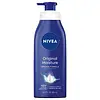What's inside
What's inside
 Key Ingredients
Key Ingredients

No key ingredients
 Benefits
Benefits

 Concerns
Concerns

 Ingredients Side-by-side
Ingredients Side-by-side

Water
Skin ConditioningParaffinum Liquidum
EmollientGlycerin
HumectantIsopropyl Palmitate
EmollientGlyceryl Stearate Se
EmulsifyingCetearyl Alcohol
EmollientTocopheryl Acetate
AntioxidantLanolin Alcohol
EmollientIsopropyl Myristate
EmollientParfum
MaskingCarbomer
Emulsion StabilisingHydroxypropyl Methylcellulose
Emulsion StabilisingSodium Hydroxide
BufferingPhenoxyethanol
PreservativeMethylparaben
PreservativeEthylparaben
PreservativeWater
Skin ConditioningIsopropyl Myristate
EmollientCetearyl Ethylhexanoate
EmollientGlycerin
HumectantSorbitan Sesquioleate
EmulsifyingCyclopentasiloxane
EmollientMagnesium Sulfate
Polyglyceryl-3 Ricinoleate
EmulsifyingPropylene Glycol
HumectantGoat Milk Extract
Lactobacillus
Skin ConditioningCyclodextrin
AbsorbentCera Microcristallina
Emulsion StabilisingSodium Benzoate
Masking2-Bromo-2-Nitropropane-1,3-Diol
PreservativeParfum
MaskingLinalool
PerfumingButylphenyl Methylpropional
PerfumingCitronellol
PerfumingHexyl Cinnamal
PerfumingGeraniol
PerfumingEugenol
PerfumingBenzyl Salicylate
PerfumingAlpha-Isomethyl Ionone
PerfumingCoumarin
PerfumingLimonene
PerfumingCitric Acid
BufferingWater, Isopropyl Myristate, Cetearyl Ethylhexanoate, Glycerin, Sorbitan Sesquioleate, Cyclopentasiloxane, Magnesium Sulfate, Polyglyceryl-3 Ricinoleate, Propylene Glycol, Goat Milk Extract, Lactobacillus, Cyclodextrin, Cera Microcristallina, Sodium Benzoate, 2-Bromo-2-Nitropropane-1,3-Diol, Parfum, Linalool, Butylphenyl Methylpropional, Citronellol, Hexyl Cinnamal, Geraniol, Eugenol, Benzyl Salicylate, Alpha-Isomethyl Ionone, Coumarin, Limonene, Citric Acid
 Reviews
Reviews

Ingredients Explained
These ingredients are found in both products.
Ingredients higher up in an ingredient list are typically present in a larger amount.
Glycerin is already naturally found in your skin. It helps moisturize and protect your skin.
A study from 2016 found glycerin to be more effective as a humectant than AHAs and hyaluronic acid.
As a humectant, it helps the skin stay hydrated by pulling moisture to your skin. The low molecular weight of glycerin allows it to pull moisture into the deeper layers of your skin.
Hydrated skin improves your skin barrier; Your skin barrier helps protect against irritants and bacteria.
Glycerin has also been found to have antimicrobial and antiviral properties. Due to these properties, glycerin is often used in wound and burn treatments.
In cosmetics, glycerin is usually derived from plants such as soybean or palm. However, it can also be sourced from animals, such as tallow or animal fat.
This ingredient is organic, colorless, odorless, and non-toxic.
Glycerin is the name for this ingredient in American English. British English uses Glycerol/Glycerine.
Learn more about GlycerinIsopropyl Myristate is an emollient, thickening agent, and texture enhancer. It is created from isopropyl alcohol and myristic acid.
It is used to help other ingredients be better absorbed. It is also an emollient and may help soften and hydrate the skin.
The comedogenic rating of this ingredient depends on the concentration. Lower amounts results in a lower rating.
Isopropyl Myristate may not be fungal acne safe. It can potentially worsen acne prone skin.
Learn more about Isopropyl MyristateParfum is a catch-all term for an ingredient or more that is used to give a scent to products.
Also called "fragrance", this ingredient can be a blend of hundreds of chemicals or plant oils. This means every product with "fragrance" or "parfum" in the ingredients list is a different mixture.
For instance, Habanolide is a proprietary trade name for a specific aroma chemical. When used as a fragrance ingredient in cosmetics, most aroma chemicals fall under the broad labeling category of “FRAGRANCE” or “PARFUM” according to EU and US regulations.
The term 'parfum' or 'fragrance' is not regulated in many countries. In many cases, it is up to the brand to define this term.
For instance, many brands choose to label themselves as "fragrance-free" because they are not using synthetic fragrances. However, their products may still contain ingredients such as essential oils that are considered a fragrance by INCI standards.
One example is Calendula flower extract. Calendula is an essential oil that still imparts a scent or 'fragrance'.
Depending on the blend, the ingredients in the mixture can cause allergies and sensitivities on the skin. Some ingredients that are known EU allergens include linalool and citronellol.
Parfum can also be used to mask or cover an unpleasant scent.
The bottom line is: not all fragrances/parfum/ingredients are created equally. If you are worried about fragrances, we recommend taking a closer look at an ingredient. And of course, we always recommend speaking with a professional.
Learn more about ParfumWater. It's the most common cosmetic ingredient of all. You'll usually see it at the top of ingredient lists, meaning that it makes up the largest part of the product.
So why is it so popular? Water most often acts as a solvent - this means that it helps dissolve other ingredients into the formulation.
You'll also recognize water as that liquid we all need to stay alive. If you see this, drink a glass of water. Stay hydrated!
Learn more about Water